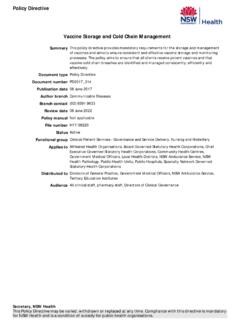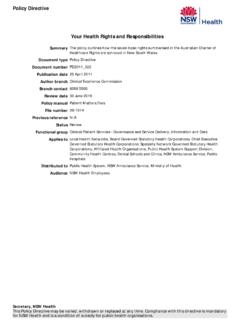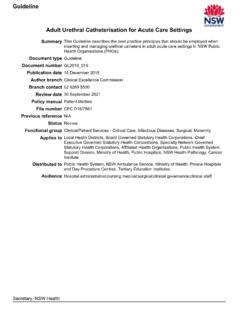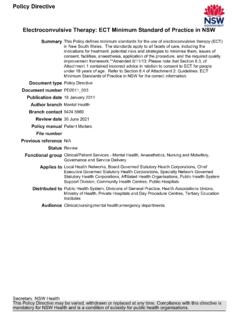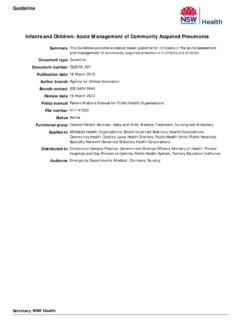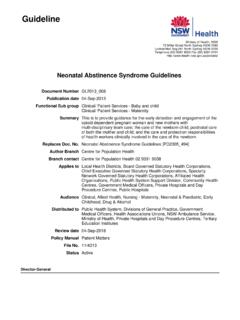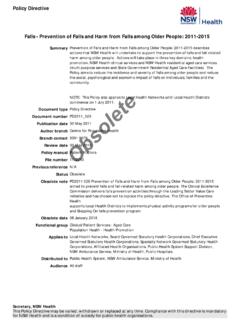Transcription of Clozapine-induced Myocarditis - Monitoring Protocol
1 Clozapine-induced Myocarditis - Monitoring ProtocolSummaryClozapine is an effective antipsychotic for the management of treatment-resistant schizophrenia. All patients taking clozapine are registered at an approved clozapine Monitoring service where ongoing Monitoring primarily occurs for the detection of neutropenia and range of cardiac disorders has been associated with the use of clozapine , the most serious being Myocarditis and cardiomyopathy. Myocarditis is most commonly observed early in treatment. The Protocol put forward in the policy recommends a way to actively monitor mental healthpatients on clozapine . It encourages continuation of clozapine in the presence of mildillness, but defines a threshold for cessation and how to manage : A correction was made on 1 February 2012 to the second sentence of the second paragraph in this Summary.
2 Cardiomyopathy replaced with typePolicy DirectiveDocument numberPD2012_005 Publication date19 January 2012 Author branchMental HealthBranch contact9424 5807 Review date30 June 2021 Policy manualPatient MattersFile number10/4566 Previous referenceN/AStatusReviewFunctional groupClinical/Patient Services - Mental HealthApplies toLocal Health Districts, Specialty Network Governed Statutory Health Corporations, Affiliated Health Organisations, Public Health Units, Public HospitalsDistributed toPublic Health System, Divisions of General Practice, Government Medical Officers, NSW Ambulance Service, Ministry of HealthAudienceNursing;clinical;emergency depts;mental health unitsPolicy DirectiveSecretary, NSW HealthThis Policy Directive may be varied, withdrawn or replaced at any time.
3 Compliance with this directive is mandatory for NSW Health and is a condition of subsidy for public health organisations. POLICY STATEMENT PD2012_005 Issue date: January 2012 Page 1 of 1 Monitoring Protocol FOR Clozapine-induced Myocarditis PURPOSE The Protocol put forward in this policy recommends a way to actively monitor mental health patients on clozapine . clozapine is an effective antipsychotic for the management of treatment-resistant schizophrenia. All patients taking clozapine are registered at an approved clozapine Monitoring service where ongoing Monitoring is required for the detection of neutropenia and agranulocytosis. The policy encourages the continuation of clozapine in the presence of mild illness, but defines a threshold for cessation and how to manage this.
4 MANDATORY REQUIREMENTS Gaining a better understanding of the potential risks associated with clozapine will enable NSW Health staff to ensure that appropriate protocols and guidelines for the effective Monitoring and management of patients taking clozapine are in place. IMPLEMENTATION Implementation of this Policy Directive will be guided by the NSW Health Monitoring Protocol for clozapine Induced Myocarditis Procedures. The document outlines a range of cardiac disorders that has been associated with the use of clozapine , recommends the typical clinical course of Myocarditis and puts forward the recommended Monitoring Protocol for the detection of neutropenia and agranulocytosis.
5 Local Health Districts and other NSW Health organisations will be required to regularly report on the progress of the Monitoring Protocol . REVISION HISTORY Version Approved by Amendment notes January 2012 (PD2012_005) Deputy Director-General Strategy and Resources New policy ATTACHMENTS 1. Monitoring Protocol for Clozapine-induced Myocarditis : Procedure Monitoring Protocol for Clozapine-induced Myocarditis PROCEDURE Issue date: January 2012 PD2012_005 Monitoring Protocol for Clozapine-induced Myocarditis PROCEDURE PD2012_005 Issue date: January 2012 Contents Page CONTENTS 1 BACKGROUND .. 1 2 DEFINITIONS .. 1 3 TYPICAL CLINICAL COURSE OF Myocarditis .
6 2 4 Monitoring Protocol .. 2 5 CONTINUATION OF clozapine WITH MILD DISEASE .. 5 6 MANAGING Myocarditis .. 5 7 ADDITIONAL INFORMATION .. 5 Monitoring Protocol for Clozapine-induced Myocarditis PROCEDURE PD2012_005 Issue date: January 2012 Page 1 of 5 1 BACKGROUND clozapine is an effective antipsychotic for the management of treatment-resistant schizophrenia. All patients taking clozapine are registered at an approved clozapine Monitoring service where ongoing Monitoring primarily occurs for the detection of neutropenia and agranulocytosis. A range of cardiac disorders has been associated with the use of clozapine , the most serious being Myocarditis , cardiomyopathy and death.
7 Myocarditis is most commonly observed early in treatment. This procedure recommends active Monitoring for the first 4 weeks, relying on assessing clinical symptoms and signs, as well as investigations such as troponin and C-reactive protein results. It encourages continuation of clozapine in the presence of mild illness, but defines a threshold for cessation. Recommended ongoing Monitoring for cardiac disorders should include: BP- admission at week 6, week 18, 6 months and thereafter unless problematic ECG - 6 months and annually thereafter unless clinically indicated ECHO - 6 months, then thereafter if clinically indicated Troponin & CRP Pre, first 4 weeks, week 6, week 18, at 6 months and thereafter 6 monthly unless clinically indicated CK-MB and NT-proBNP also advised should Myocarditis be suspected.
8 2 DEFINITIONS Troponin I or T- The troponin test measures the levels of one of two proteins, troponin T or troponin I, in a blood sample. These proteins are released when the heart muscle has been damaged, such as during a heart attack. The more damage there is to the heart, the greater the amount of troponin T and I there will be in the blood. Range: <14ng/L CRP- C- reactive protein - is produced by the liver. The level of CRP rises when there is inflammation throughout the body. Range: <5mg/L NT-proBNP- N-terminal B-type natriuretic peptide is released by the ventricular wall in response to increased wall stress and reflects the haemodynamic status of the heart.
9 Useful for detecting early and initially asymptomatic Myocarditis . CK-MB- Creatine Kinase - Myocardial Band is a cardiac marker used to assist diagnoses of an acute myocardial injury. ULN- Upper Limit of Normal LV- Left Ventricular Monitoring Protocol for Clozapine-induced Myocarditis PROCEDURE PD2012_005 Issue date: January 2012 Page 2 of 5 3 TYPICAL CLINICAL COURSE OF Myocarditis The first indications of the onset of Myocarditis are non-specific symptoms of illness such as fever with features commonly associated with influenza, but symptoms may include severe diarrhoea and vomiting or dysuria (point 2, Figure 1). C reactive protein (CRP) usually begins to increase around this time (point 2, Figure 1).
10 Troponin I or T typically increases with a delay of as much as 5 days after both the onset of symptoms and commencement in the rise of CRP (Point 3, Figure 1). A sudden drop in systolic blood pressure may occur around this time and the patient may report chest pain (Point 3, Figure 1). The first appearance of non-specific electrocardiogram (ECG) changes also occurs at this point (Point 3, Figure 1). Basal crepitations, third heart sounds, peripheral oedema and raised jugular venous pressure also may develop (Point 3, Figure 1). An ECHO may show impairment of left ventricular function (Point 3, Figure 1). Heart rate typically increases a few days following initiation of clozapine in all patients including those not developing Myocarditis .

